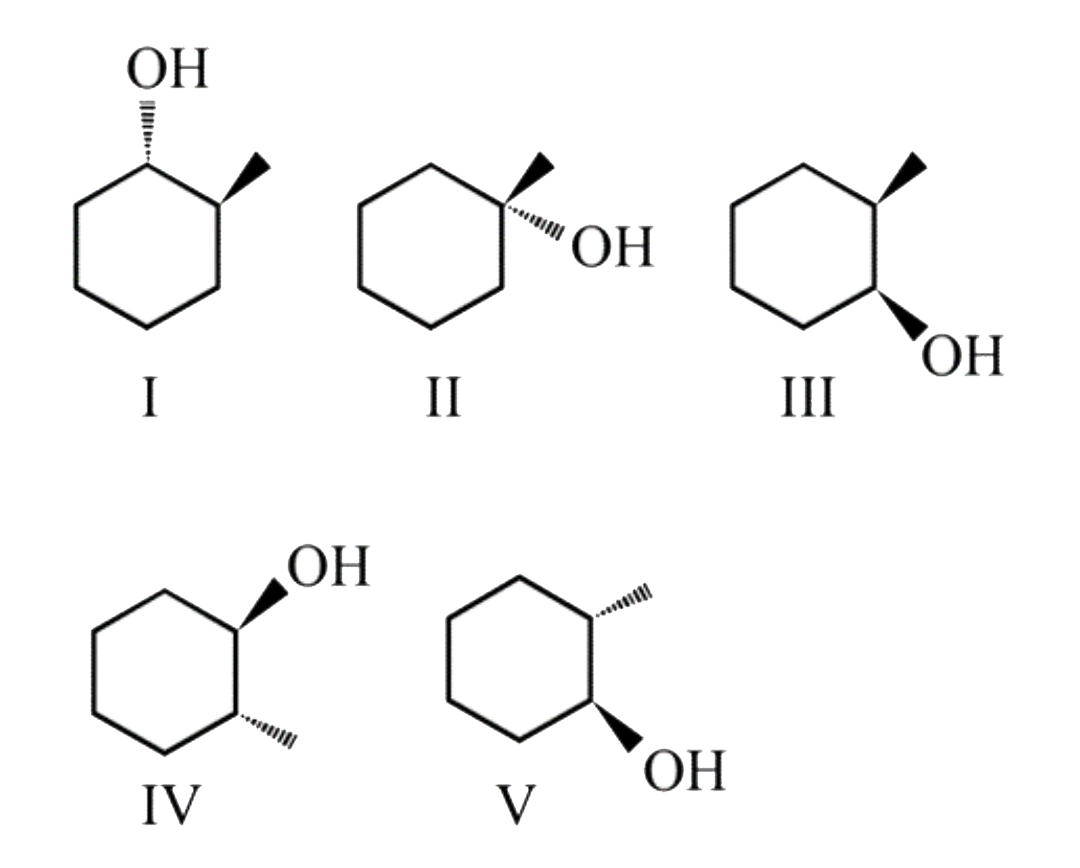Oxymercuration -demurcuration reaction of 1-methyl cyclohexene gives
cis-2-Methyl cyclohexene gives
trans-2-Methyl cyclohexanol
1-Methyl cyclohexanol
Mixture of cis and trans-2-methyl cyclohexanol.
The correct Answer is:C
To solve the problem of the oxymercuration-demercuration reaction of 1-methylcyclohexene, we can follow these steps:
Step 1: Understand the Reaction Mechanism
The oxymercuration-demercuration reaction involves two main steps:
1. Oxymercuration: The alkene reacts with mercuric acetate (Hg(OAc)₂) in the presence of water to form a mercurial alcohol intermediate.
2. Demercuration: The mercurial intermediate is then treated with sodium borohydride (NaBH4) to remove the mercury and form the final alcohol product.
Hint: Remember that oxymercuration follows Markovnikov's rule, where the more substituted carbon atom gets the -OH group.
Step 2: Identify the Starting Material
We start with 1-methylcyclohexene, which is a cyclic alkene with a methyl group attached to one of the carbon atoms in the ring.
Hint: Visualize the structure of 1-methylcyclohexene to understand where the double bond and the methyl group are located.
Step 3: Perform Oxymercuration
In the oxymercuration step, mercuric acetate reacts with 1-methylcyclohexene. The double bond of the alkene attacks the mercury, leading to the formation of a cyclic mercurinium ion. Water then attacks the more substituted carbon of the mercurinium ion, resulting in the formation of a mercurial alcohol intermediate.
Hint: Focus on the regioselectivity of the attack by water, which will lead to the formation of the more stable carbocation.
Step 4: Perform Demercuration
In the demercuration step, the mercurial alcohol intermediate is treated with sodium borohydride (NaBH4). This step replaces the mercury with a hydrogen atom, yielding the final alcohol product.
Hint: Remember that the demercuration step is crucial for removing the mercury and forming the final alcohol.
Step 5: Identify the Final Product
After completing the oxymercuration-demercuration reaction, the product formed is 1-methylcyclohexanol. This is the alcohol where the hydroxyl (-OH) group is added to the more substituted carbon of the original alkene.
Hint: Check the structure of 1-methylcyclohexanol to confirm that the -OH group is correctly positioned.
Final Answer
The oxymercuration-demercuration reaction of 1-methylcyclohexene gives 1-methylcyclohexanol.
The oxymercuration-demercuration reaction involves two main steps:
1. Oxymercuration: The alkene reacts with mercuric acetate (Hg(OAc)₂) in the presence of water to form a mercurial alcohol intermediate.
2. Demercuration: The mercurial intermediate is then treated with sodium borohydride (NaBH4) to remove the mercury and form the final alcohol product.
We start with 1-methylcyclohexene, which is a cyclic alkene with a methyl group attached to one of the carbon atoms in the ring.
In the oxymercuration step, mercuric acetate reacts with 1-methylcyclohexene. The double bond of the alkene attacks the mercury, leading to the formation of a cyclic mercurinium ion. Water then attacks the more substituted carbon of the mercurinium ion, resulting in the formation of a mercurial alcohol intermediate.
In the demercuration step, the mercurial alcohol intermediate is treated with sodium borohydride (NaBH4). This step replaces the mercury with a hydrogen atom, yielding the final alcohol product.
After completing the oxymercuration-demercuration reaction, the product formed is 1-methylcyclohexanol. This is the alcohol where the hydroxyl (-OH) group is added to the more substituted carbon of the original alkene.
The oxymercuration-demercuration reaction of 1-methylcyclohexene gives 1-methylcyclohexanol.
Topper's Solved these Questions
- BOOK - DINESH PUBLICATIONCHAPTER - NO IDEAEXERCISE - Unit Test -1videos
NO IDEA
- BOOK - DINESH PUBLICATIONCHAPTER - NO IDEAEXERCISE - Brain Teasers -501videos
NO IDEA
- BOOK - DINESH PUBLICATIONCHAPTER - IONIC EQUILIBRIUM EXERCISE - UNIT TEST -230videos
IONIC EQUILIBRIUM
- BOOK - DINESH PUBLICATIONCHAPTER - ORGANIC COMPOUNDS WITH FUNCTIONAL GROUP CONTAINING HALOGENS EXERCISE - UNIT TEST - 537videos
ORGANIC COMPOUNDS WITH FUNCTIONAL GROUP CONTAINING HALOGENS
Similar Questions
Knowledge Check
- Question 1 - Select One
Methylation of methyl amine gives
A(CH3)3NB(CH3)2NHC(CH3)4N+IDAll of these - Question 2 - Select One
Hydroboration oxidation of 3-methyl but-1-ene gives
A3-methylbutan-2-olB2-methylbutan-2-olC3-methylbutan-1-olD2-methylbutan-1-ol - Question 3 - Select One
What is the product of the reaction of methyl cyclohexene with BH3 - THF followed by oxidation with alkaline H2O2 ?
 AII and IIIBIICIII and IVDI and IV
AII and IIIBIICIII and IVDI and IV
Preparation OF Alcohol and Ether by Acidic Hydration || Oxymercuration Demercuration reaction || Hydroboration oxidation || Reaction OF R-X with HOH and NaOH ( by SN-Reaction )
View SolutionAcid-catalysed hydration oxymercuration-demercu-ration, and hydroboration oxidation reaction will give the same product with:
View SolutionAddition of Hi in 2-methyl but- 1-en gives
View SolutionHBO, oxymercuration-demercuration and acid catalysed hydration will not give not give same product in :
View Solutionthe complete methylation of methyl ethanamine gives
View Solution

